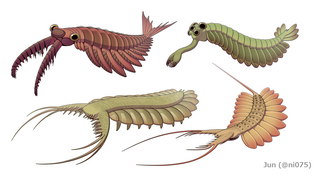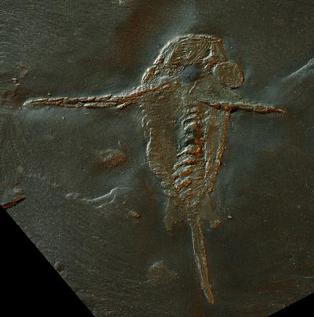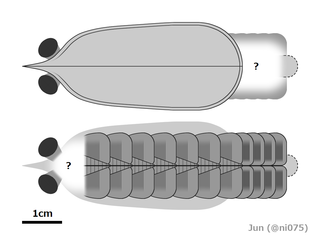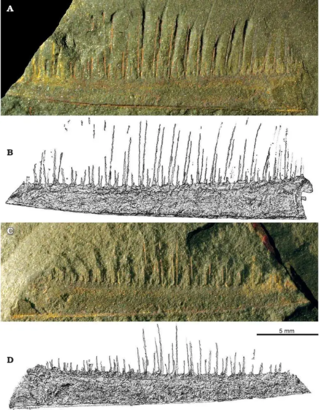
Dinocaridida is a proposed fossil taxon of basal arthropods that flourished in the Cambrian period with occasional Ordovician and Devonian records. Characterized by a pair of frontal appendages and series of body flaps, the name of Dinocaridids comes from Greek, "deinos" and "caris", referring to the suggested role of some of these members as the largest marine predators of their time. Dinocaridids are occasionally referred to as the 'AOPK group' by some literatures, as the group compose of Radiodonta, Opabiniidae, and the "gilled lobopodians" Pambdelurion and Kerygmachela. It is most likely paraphyletic, with Kerygmachela and Pambdelurion more basal than the clade compose of Opabiniidae, Radiodonta and other arthropods.

Anomalocaris is an extinct genus of radiodont, an order of early-diverging stem-group arthropods.

Anomalocarididae is an extinct family of Cambrian radiodonts, a group of stem-group arthropods.

Parapeytoia is a genus of extinct arthropod that lived over 530 million years ago in the Maotianshan shales of prehistoric China. It was interpreted as an anomalocaridid (radiodont) with legs, but later studies reveal it was a megacheiran, a group of arthropods which are no longer thought to be closely related to the radiodonts.

Peytoia infercambriensis is a species of hurdiid radiodont in the genus Peytoia.

Schinderhannes bartelsi is a species of hurdiid radiodont (anomalocaridid) known from one specimen from the lower Devonian Hunsrück Slates. Its discovery was astonishing because previously, radiodonts were known only from exceptionally well-preserved fossil beds (Lagerstätten) from the Cambrian, 100 million years earlier.

Radiodonta is an extinct order of stem-group arthropods that was successful worldwide during the Cambrian period. They may be referred to as radiodonts, radiodontans, radiodontids, anomalocarids, or anomalocaridids, although the last two originally refer to the family Anomalocarididae, which previously included all species of this order but is now restricted to only a few species. Radiodonts are distinguished by their distinctive frontal appendages, which are morphologically diverse and used for a variety of functions. Radiodonts included the earliest large predators known, but they also included sediment sifters and filter feeders. Some of the most famous species of radiodonts are the Cambrian taxa Anomalocaris canadensis, Hurdia victoria, Peytoia nathorsti, Titanokorys gainessii, Cambroraster falcatus and Amplectobelua symbrachiata, the Ordovician Aegirocassis benmoulai and the Devonian Schinderhannes bartelsi.

Hurdia is an extinct genus of hurdiid radiodont that lived 505 million years ago during the Cambrian Period. Fossils have been found in North America, China and the Czech Republic.

Stanleycaris is an extinct, monotypic genus of hurdiid radiodont from the middle Cambrian (Miaolingian). The type species is Stanleycaris hirpex. Stanleycaris was described from the Stephen Formation near the Stanley Glacier and Burgess Shale locality of Canada, as well as Wheeler Formation of United States. The genus was characterized by the rake-like frontal appendages with robust inner spines.

Caryosyntrips ("nutcracker") is an extinct genus of radiodont which known from Canada, United States and Spain during the middle Cambrian. Caryosyntrips is known only from its 14-segmented frontal appendages, which resemble nutcrackers, recovered from the Burgess Shale Formation, Canada, Wheeler Shale and Marjum Formation, United States, and Valdemiedes Formation, Spain. It was first named by Allison C. Daley, Graham E. Budd in 2010 and the type species is Caryosyntrips serratus. Caryosyntrips is thought to have used their appendages in a scissor-like grasping or slicing motion, and were probably durophagous, feeding on hard-shelled organisms. Due to the unusual morphology of the frontal appendages and the limited extent of known remains, its position within Radiodonta remains uncertain.

Tamisiocaris is a radiodont genus initially only known from frontal appendages from the Cambrian Sirius Passet lagerstatte in northern Greenland. It was initially described initially in 2010. Further study in 2014 revealed that the frontal appendages were segmented and bore densely-packed auxiliary spines, which were adapted to suspension feeding in a manner analogous to modern baleen whales. It is assigned to the family Tamisiocarididae, and is measured about 34 cm (1.12 ft) long in total body length.

All Yesterdays: Unique and Speculative Views of Dinosaurs and Other Prehistoric Animals is a 2012 art book on the palaeoartistic reconstruction of dinosaurs and other extinct animals by John Conway, C. M. Kosemen and Darren Naish. A central tenet of the book concerns the fact that many dinosaur reconstructions are outdated, overly conservative, and inconsistent with the variation observed in modern animals. This focus is communicated through an exploration of views of dinosaurs and related animals that are unusual and sometimes even confusing to viewers, but which are well within the bounds of behaviour, anatomy and soft tissue that we see in living animals.

Amplectobeluidae is a clade of Cambrian radiodonts.

Lyrarapax is a radiodont genus of the family Amplectobeluidae that lived in the early Cambrian period 520 million years ago. Its neural tissue indicates that the radiodont frontal appendage is protocerebral, resolving parts of the arthropod head problem and showing that the frontal appendage is homologous to the antennae of Onychophorans and labrum of euarthropods. Its fossilized remains were found in Yunnan in southwestern China. A second species was described in 2016, differing principally in the morphology of its frontal appendages. It is a small animal, measuring up to 8 cm (3.1 in) in total body length.

Aegirocassis is an extinct genus of giant radiodont arthropod belonging to the family Hurdiidae that lived 480 million years ago during the early Ordovician in the Fezouata Formation of Morocco. It is known by a single species, Aegirocassis benmoulai. Van Roy initiated scientific study of the fossil, the earliest known of a "giant" filter-feeder discovered to date. Aegirocassis is considered to have evolved from early predatory radiodonts. This animal is characterized by its long, forward facing head sclerite, and the endites on its frontal appendages that bore copious amounts of baleen-like auxiliary spines. This animal evolving filter-feeding traits was most likely a result of the Great Ordovician Biodiversification Event, when environmental changes caused a diversification of plankton, which in turn allowed for the evolution of new suspension feeding lifeforms. Alongside the closely related Pseudoangustidontus, an unnamed hurdiid from Wales, the middle Ordovician dinocaridid Mieridduryn, and the Devonian hurdiid Schinderhannes this radiodont is one of the few known dinocaridids known from post-Cambrian rocks.

Hurdiidae is an extinct cosmopolitan family of radiodonts, a group of stem-group arthropods, which lived during the Paleozoic Era. It is the most long-lived radiodont clade, lasting from the Cambrian period to the Devonian period.

Houcaris is a possibly paraphyletic radiodont genus, tentatively assigned to Tamisiocarididae, known from Cambrian Series 2 of China and the United States. It contains two species, Houcaris saron and Houcaris magnabasis, both of which were originally named as species of the related genus Anomalocaris. The genus Houcaris was established for the two species in 2021 and honors Hou Xianguang, who had discovered and named the type species Anomalocaris saron in 1995 along with his colleagues Jan Bergström and Per E. Ahlberg.

Erratus is an extinct genus of marine arthropod from the Cambrian of China. Its type and only species is Erratus sperare. Erratus is likely one of the most basal known arthropods, and its discovery has helped scientists understand the early evolution of arthropod trunk appendages. Some of the stem-arthropods like radiodonts did not have legs, instead they had flap like appendages that helped them swim. Erratus on the other hand had not only flaps but also a set of primitive legs. It also supported the theory that the gills of aquatic arthropods probably evolved into the wings and lungs of terrestrial arthropods later in the Paleozoic.

Laminacaris is a genus of extinct stem-group arthropods (Radiodonta) that lived during the Cambrian period. It is monotypic with a single species Laminacaris chimera, the fossil of which was described from the Chengjiang biota of China in 2018. Around the same time, two specimens that were similar or of the same species were discovered at the Kinzers Formation in Pennsylvania, USA. The first specimens from China were three frontal appendages, without the other body parts.

Aegirocassisinae is a subfamily of radiodonts from the lower Paleozoic era. It belongs to the larger hurdiidae family, which were the most diverse and long lasting radiodonts. The members of this subfamily are restricted to the lower Ordovician aged Fezouata Formation of Morocco. Currently only two genera are included: Aegirocassis and Pseudoangustidontus. These two genera possess large Baleen-like auxiliary spines on their frontal appendages, which suggests a suspension feeding lifestyle for the group. These radiodonts are some of the few known from sediments beyond the Cambrian period. This subfamily shows that following the Great Ordovician Biodiversification Event, which saw a rise in the plankton population in the worlds oceans, suspension feeding became more common in radiodonts then other feeding styles. It also seems that due to the evolution of new predators, like large nautiloid cephalopods, and other arthropod groups like the eurypterids, the radiodonts evolved suspension feeding lifestyles in order to minimize competition for food.

























